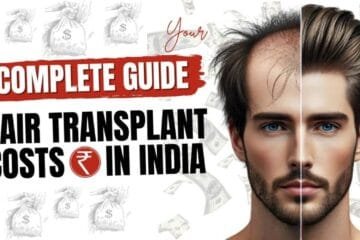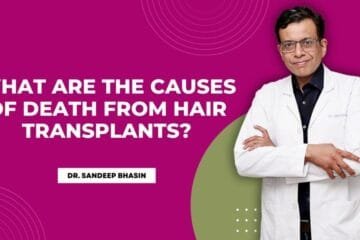One of the most common questions I hear is, “Doctor, what is FUE hair transplant and will it work for me?” Many ask this after years of trying oils, medicines, or home remedies. At this stage, many patients explore professional hair loss treatment in Delhi when home remedies stop working.
In simple words, FUE (Follicular Unit Extraction) hair transplant means I take out tiny hair roots from the back of your scalp and place them carefully in bald or thinning areas. The hair grows naturally, without leaving a long scar.
And here’s what I love most.
It’s not just about new hair — it’s about new confidence.
I still remember a young man who wore a cap to every appointment. After his FUE transplant, he came back smiling — without the cap. Moments like these remind me why this procedure is so powerful.
So, let me guide you through FUE the same way I explain it to my patients — step by step, with clear answers on cost, recovery, and results.
Understanding Hair Loss Before FUE
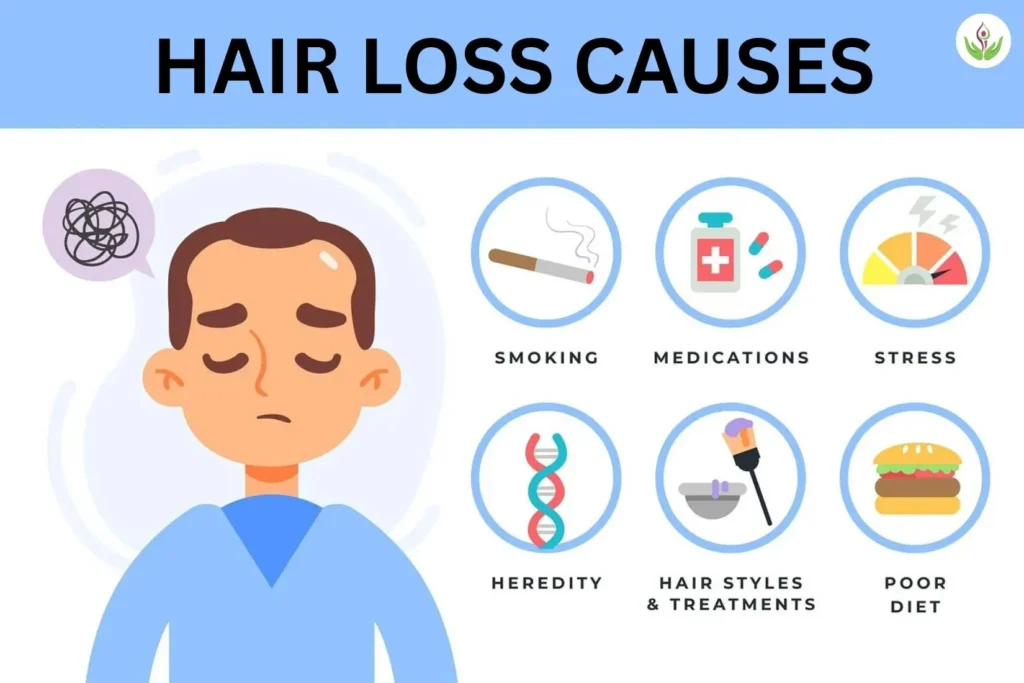
When someone asks me about hair transplant, my first step is simple — understand why their hair is falling. Without that, no treatment works.
Causes I See Often
For most men, it’s genetic. We call it androgenetic alopecia — or pattern baldness. Such cases often need advanced solutions like advanced hair transplant in Delhi for permanent restoration. It’s driven by a hormone called DHT that shrinks the roots over time.
But that’s not the whole story. Hormonal changes, thyroid issues, nutritional gaps, even stress — all can trigger shedding. In such cases, supportive therapies like PRP hair treatment in Delhi can help strengthen weak follicles and slow down hair fall. I have also treated patients who lost hair after high fever or scalp infections. Lifestyle matters too. Smoking, poor diet, harsh chemicals, or tight hairstyles make it worse.
Common Types in My Practice
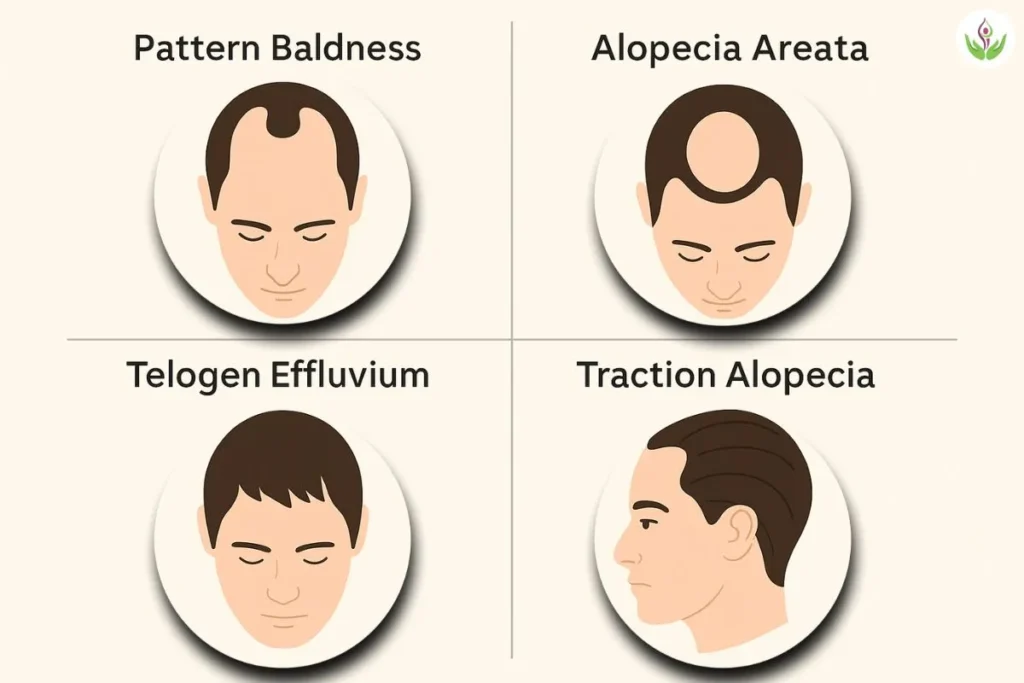
- Pattern Baldness: Receding hairline or thinning crown.
- Alopecia Areata: Sudden round patches — autoimmune in nature.
- Telogen Effluvium: Sudden shedding after stress, illness, or surgery. Usually temporary.
- Traction Alopecia: From tight ponytails or braids pulling on roots.
Hair loss is as much emotional as it is medical.
I have seen young professionals avoid photographs or feel years older just because of a receding line. That’s why, for me, treating hair loss is not about vanity — it’s about restoring confidence.
What is FUE Hair Transplant Procedure?

So, what exactly is FUE hair transplant in Delhi? In plain words, I remove tiny hair roots one by one
In plain words, I remove tiny hair roots one by one from the back of your scalp and place them in bald areas. No strip cuts, no long scar.
How I Explain It to My Patients
- Local Anesthesia – First, I numb the donor and recipient areas. You stay awake, and most patients tell me, “Doctor, that was easier than I expected.”
- Follicle Extraction – With a micro-punch tool, I pick individual hair roots from the donor zone. These are permanent hairs.
- Recipient Site Prep – I design the hairline and make tiny openings. Angle and direction matter here — it’s what makes results natural.
- Graft Implantation – Each follicle is placed into these sites with precision. Patients are often surprised at how natural even the early design looks.
- Healing Phase – Small scabs form, usually gone in 7–10 days. Most people feel normal within a couple of days.
- Time Required – A 1500 graft session takes 4–5 hours. Bigger cases can take 7–9 hours, sometimes over two sittings.
By the end of this explanation, most patients smile and say, “Doctor, this sounds much simpler than I imagined.”
Benefits of FUE Hair Transplant
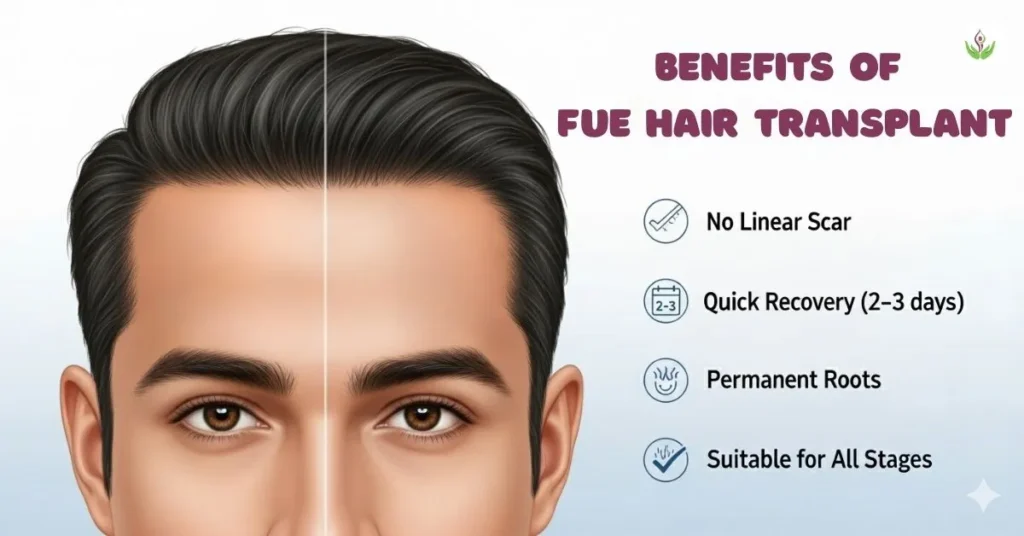
When patients ask me, “Doctor, will the result look natural?” — I know that’s their biggest worry. Let me explain the real benefits of FUE.
Natural Results, No Linear Scar
I design the hairline using single-hair grafts in front and thicker ones behind. This layering makes the result undetectable. One of my patients once said, “Even my barber couldn’t tell I had a transplant.” That, for me, is success. And unlike FUT, there’s no long stitch line — only tiny dot marks that fade. If you’re confused between techniques, I’ve explained it in detail in my guide on FUE vs FUT hair transplant.
Minimally Invasive, Faster Recovery
Since there are no stitches, recovery is quick. Many patients go back to work in 2–3 days. By the end of the first week, scabs usually fall off. One patient even joked, “Doctor, people at my office thought I was just on leave for a cold.”
Permanent Results
The follicles I use come from the donor zone — naturally resistant to balding. Once implanted, they usually last for life. This is what we call “donor dominance.” Patients feel reassured when I tell them, “These are the safest, strongest roots you have.”
Suitable for Different Stages of Baldness
FUE works whether it’s a small hairline correction or advanced baldness. In larger cases, I may even combine scalp and beard hair for better coverage. This flexibility makes it ideal for most patients I see.
In the end, the real benefit is not just new hair — it’s the confidence people rediscover. And that, I believe, is priceless.
Risks & Side Effects of FUE
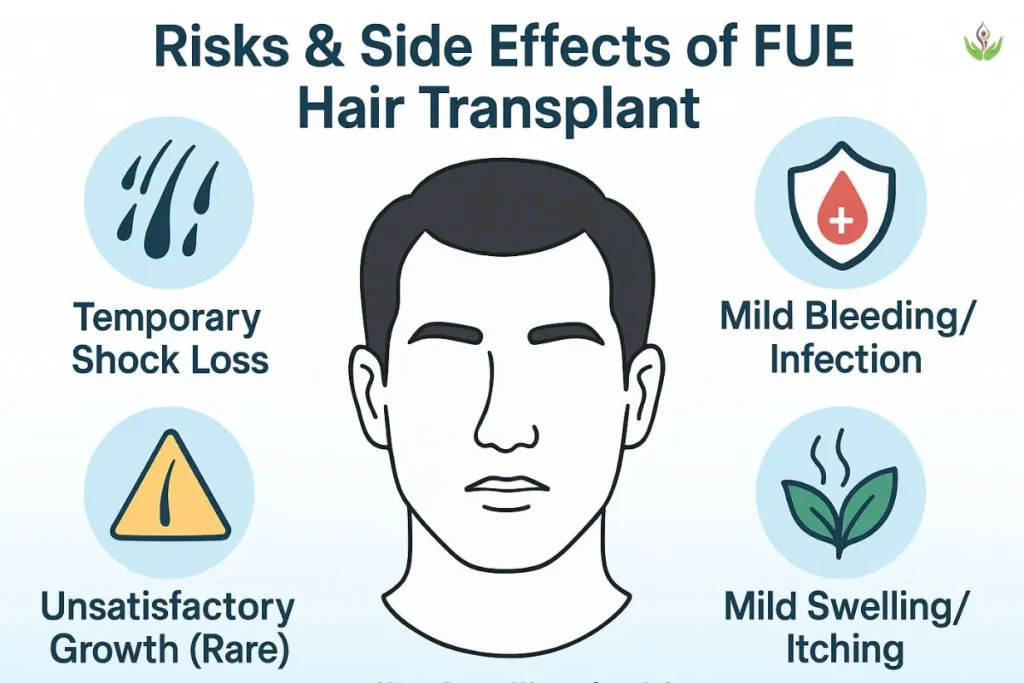
I always tell my patients — no surgery is risk-free. Knowing the possible side effects helps you prepare and avoid unnecessary panic.
Temporary Shock Loss
Some hair around the transplanted zone may fall out in the first few weeks. It can be scary. I remember a young man who called me in panic after this happened. Four months later, he came back smiling — his hair had grown back stronger.
Mild Bleeding or Infection
A little bleeding is normal. Infection is rare if aftercare is followed. I prescribe antibiotics and teach simple hygiene steps. With these, 99% of patients heal without issues.
Tiny Dot Scars
Yes, there are scars — but they’re pinhead-sized. With modern punches (0.7–0.9 mm), they’re hardly visible. Even patients who like short hairstyles are usually satisfied.
Unsatisfactory Growth in Rare Cases
Results depend on donor quality and graft handling. Inexperienced surgery can reduce success. That’s why I insist: always choose a trained surgeon, not just a cheap package. If you’re unsure how to decide, my article on the best hair transplant clinic in Delhi explains what to look for.
And yes, minor issues like swelling or itching can happen. But with proper care, they pass quickly. Most patients tell me, “Doctor, it wasn’t as tough as I thought.”
FUE Hair Transplant Cost – India & Delhi Overview
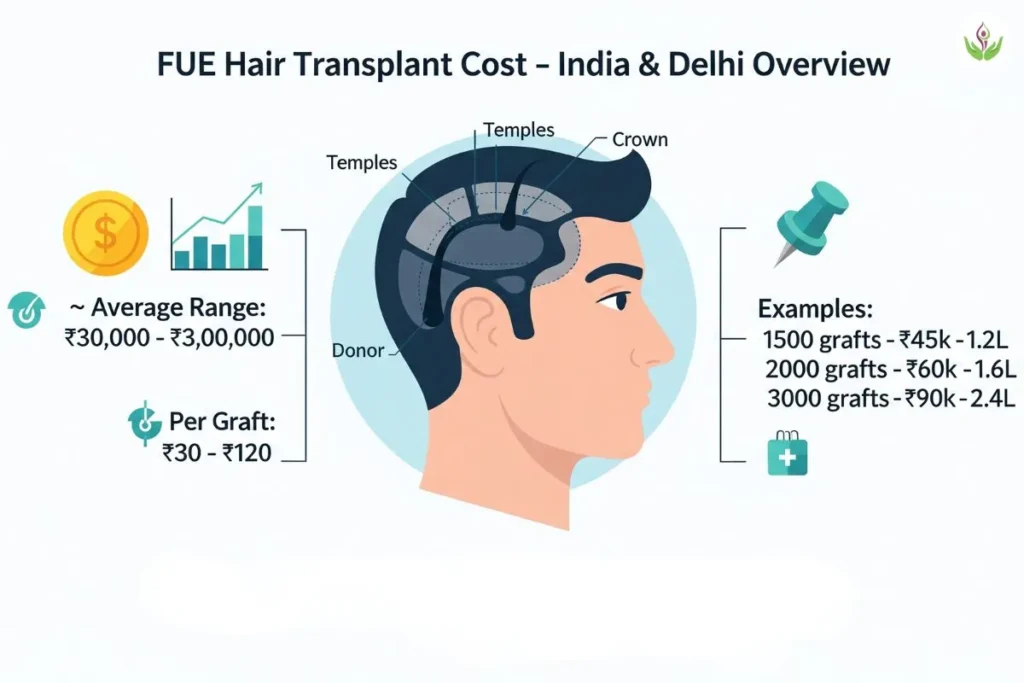
The moment I start a consultation, one of the first questions is — “Doctor, FUE hair transplant ka cost kitna hoga?” And honestly, it’s a fair question.
Average Cost Range
In Delhi and most of India, FUE hair transplant cost usually lies between ₹30,000 to ₹3,00,000. Yes, the range is wide — because everyone’s baldness pattern and graft requirement are different. For a detailed breakdown, see my hair transplant cost in Delhi page.
Cost Per Graft Explained Simply
Clinics usually charge per graft. On average, it’s around ₹30–₹120 per graft. I’ve also shared updated figures in my Hair Transplant Cost in Delhi NCR 2025 guide.
For example:
- 1500 grafts: ₹45,000 – ₹1,20,000
- 2000 grafts: ₹60,000 – ₹1,60,000
- 3000 grafts: ₹90,000 – ₹2,40,000
I remember one patient who panicked hearing “3000 grafts.” He thought it meant 3 lakh rupees! When I broke it down per graft, he smiled and said, “Doctor, ab to samajh aaya — it’s not as scary as I imagined.”
Factors That Change the Price
- Surgeon’s Skill: An experienced doctor may charge more, but gives safer, natural results.
- Technique Used: Standard FUE, Bio-FUE (with growth factors), or DHI (Direct Hair Implant) all differ in cost.
- Number of Sessions: Large baldness may require multiple sittings.
- Clinic Standards: OT setup, hygiene, anesthesia safety — these add to cost, but also to safety.
- Aftercare & Follow-up: Many patients forget this, but post-op support matters for overall value.
FUE vs Bio-FUE vs DHI
- FUE: ₹30–₹120 per graft (standard).
- Bio-FUE: Slightly higher, since growth factors are added for faster healing.
- DHI: Usually the costliest because it uses implanter pens and needs extra precision time.
Delhi vs Other Cities
Yes, Delhi clinics may charge a bit higher compared to smaller towns. But you also get better technology, sterilization standards, and experienced surgeons. Most patients feel this trade-off is worth it.
And here’s what I always tell people: Don’t just count rupees, count results. A bad transplant is costlier — not in money alone, but in confidence.
Recovery & Results Timeline After FUE
When patients ask me, “Doctor, recovery kaisa hoga? Results kab dikhenge?” — I usually share it like a journey. Let me take you through it step by step, exactly as most of my patients experience it.
Week 1 – Healing Stage
The scalp feels tender, and tiny scabs form around the grafts. Redness and mild swelling can appear, especially on the forehead. Many patients send me WhatsApp photos asking, “Doctor, yeh sahi lag raha hai na?” I reassure them it’s normal. By day 7–10, most scabs fall off, and the scalp looks cleaner.
Months 1–3 – The Shock Loss Phase
This is the part nobody likes. Transplanted hairs shed. Patients panic, thinking the surgery failed. I still remember one young man who almost regretted his decision at this stage. By the third month, when tiny new hairs sprouted, he laughed and said, “Doctor, ab samajh aaya, patience hi asli medicine hai.”
Month 6 – Visible Change
This is the turning point. Hair looks fuller and denser. Colleagues and friends notice something different but can’t guess what. Many patients tell me, “Doctor, people say I look fresher, but they don’t know why.” That’s when confidence quietly returns.
Month 12 – Final Results
By 9–12 months, results are complete. The transplanted hair has grown, thickened, and blended perfectly. Patients style it, cut it, even color it like normal hair. At this stage, many come back to my clinic not for a review — but just to show me their new hairstyle.
Before & After Photos




Whenever doubts remain, I show real before-and-after pictures. You can also view some of our hair transplant before and after results in Delhi to see how natural the outcomes look. These photos speak louder than my words — because seeing change gives hope that yes, this journey is worth it.
FUE vs FUT vs DHI – Which is Better?
When patients sit with me, they often say, “Doctor, itna confusing hai… FUT, FUE, DHI — kaunsa best hai?” I usually explain it like this:
FUE vs FUT (Strip Method)
FUT means a strip of scalp is cut from the back of the head. It gives a good number of grafts in one sitting, but it leaves a visible linear scar. Recovery also takes longer, and patients often feel tightness in the donor area.
FUE, on the other hand, is stitch-free. Follicles are taken out individually with micro-punches. Recovery is faster, pain is less, and there’s no long scar. Patients who like short hair almost always choose FUE.
FUE vs DHI (Direct Hair Implant)
DHI is actually a variation of FUE. Here, we use implanter pens to directly place grafts without creating separate slits. For a complete breakdown, I’ve compared all techniques in detail here: FUE vs FUT vs DHI hair transplant. This allows high precision and can give dense packing, especially in the hairline. But it’s more time-consuming, needs a bigger team, and usually costs more. Many patients ask me, “Doctor, kya DHI zyada natural lagta hai?” My answer is — results depend more on the surgeon’s skill than on the tool. A well-done FUE can look just as natural as DHI.
When Each Technique is Suitable
- I recommend FUT only when patients have very advanced baldness and want maximum grafts in one sitting — and don’t mind a scar.
- FUE is ideal for most people: minimal downtime, natural look, and flexibility with hairstyles.
- DHI works well when someone wants high density in a small area, like refining the hairline, and is ready for higher cost.
At the end of the day, I tell my patients — the “best” method is the one that matches your baldness level, your donor supply, your lifestyle, and your budget. There’s no one-size-fits-all, but in my practice, FUE balances all these factors beautifully.
Quick Comparison: FUE vs FUT vs DHI
Some patients prefer details, others like quick charts. For easy reference, here’s how I usually simplify it for them:
| Feature | FUT (Strip Method) | FUE (Follicular Unit Extraction) | DHI (Direct Hair Implant) |
| Scarring | Long stitch line at the back, may show with short hair | Tiny dot marks, usually fade and hidden | Similar dot scars, almost invisible but still present |
| Recovery Time | 2–3 weeks (stitches heal slowly) | 7–10 days, most return to work in 2–3 days | Similar to FUE, though swelling can last a bit longer |
| Pain/Discomfort | More — because of stitches and tightness | Mild, most patients describe it as “pressure” not pain | Mild, but procedure is longer so some feel restless |
| Number of Grafts | Can harvest maximum grafts in one go | Good coverage, but may need 2 sessions for very high grafts | Limited grafts per sitting — density focus, not volume |
| Cost | Usually lowest | Medium range | Highest (premium pricing) |
| Best For | Patients with advanced baldness who don’t mind a scar | Most patients — especially those who want short hairstyles and quick recovery | People wanting refined hairlines or high density, ready for more time and cost |
Conclusion – Should You Consider FUE?
FUE is among the safest and most natural-looking hair restoration techniques today. It offers permanent results, quick recovery, and freedom from visible scars. If you are struggling with hair loss, FUE can be life-changing — not just for your hairline, but for your confidence and self-image. With the right surgeon and care, results often look so natural that even close friends can’t tell the difference. If you’re ready to take the next step, explore our main service page for hair transplant in Delhi.
Frequently Asked Questions about FUE Hair Transplant
Yes. The transplanted roots come from the donor zone (back and sides), which are resistant to balding. Once they grow, they usually last a lifetime. For more details, I’ve explained this in my blog on does hair transplant give permanent results.
Not really. Local anesthesia makes the procedure comfortable. Most patients tell me later, “Doctor, I felt only pressure, not pain.” Afterward, mild soreness fades in a few days.
It can — but results depend on donor supply. In larger cases, I sometimes combine scalp and beard grafts for better coverage.
Smaller sessions (1000–1500 grafts) take 4–5 hours. Larger cases (3000+ grafts) may take 7–9 hours, sometimes spread across two days.
On average, 1500–2500 grafts are enough. But it depends on your forehead size and density goals. I always map this during consultation. You can also try our hair graft calculator to get an estimate before visiting the clinic.
Most patients are back in 2–3 days. I’ve had businessmen attend meetings the very next day, wearing a cap.
Bio-FUE combines FUE with growth factors or PRP therapy. It promotes faster healing and may boost graft survival — though it’s slightly costlier.
No serious long-term side effects are reported. Tiny dot scars remain at the donor site, but they’re usually invisible, even with short hairstyles.
Yes, absolutely. I’ve treated many women for thinning crowns and receding hairlines. The design is customized for a natural feminine look. We also offer dedicated solutions for women through our female hair transplant in Delhi service.
For most people, yes. FUE avoids the long scar and offers quicker recovery. FUT may still help in very advanced baldness when maximum grafts are needed in one go.
New growth starts by 3–4 months, visible change by 6 months. Final results appear around 9–12 months. Patience really pays off here.
Only tiny pinhead scars at the donor site. Modern punches (0.7–0.9 mm) make them fade and almost impossible to notice.
Yes. If your donor area still has reserve, a second or even third session is possible. I’ve done repeat FUEs years apart for many patients.
References:
- Evaluation of Follicular Unit Extraction Technique as a Method for Hair Transplantation — PMC article on FUE outcomes. Available at: https://pmc.ncbi.nlm.nih.gov/articles/PMC12039779/
- Follicular Unit Extraction (FUE): Curves Ahead — Analysis of FUE method, risks & technical factors. Available at: https://pmc.ncbi.nlm.nih.gov/articles/PMC6795649/
- Using the follicular unit extraction technique in treatment of male androgenetic alopecia — Study showing high survival & satisfaction rates. Available at: https://bmcsurg.biomedcentral.com/articles/10.1186/s12893-024-02655-1
- A Review of Modern Surgical Hair Restoration Techniques — Review including FUE and FUT methods. Available at: https://pmc.ncbi.nlm.nih.gov/articles/PMC2840892/
- Hair transplantation: Standard guidelines of care — Guidelines on transplant procedure, protocol. Available at: https://ijdvl.com/hair-transplantation-standard-guidelines-of-care/
- Follicular Unit Extraction [FUE] — One Procedure, Many Uses — Discusses multiple applications & benefits of FUE. Available at: https://journals.lww.com/idoj/fulltext/2021/12030/follicular_unit_extraction__fue____one_procedure%2C.1.aspx












